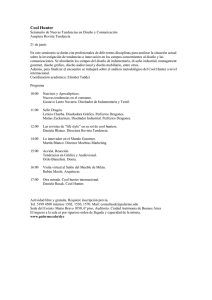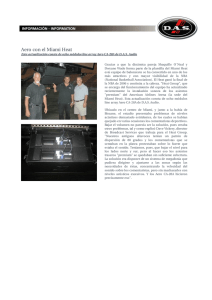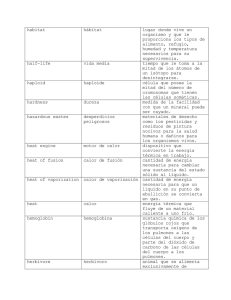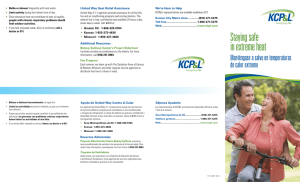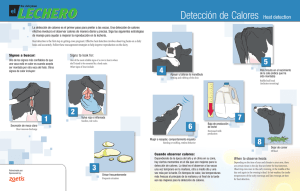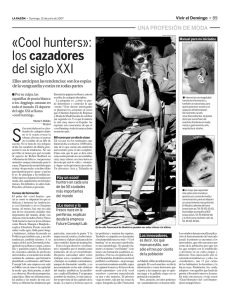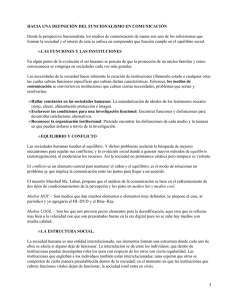The Heat Equation Heat Exhaustion
Anuncio
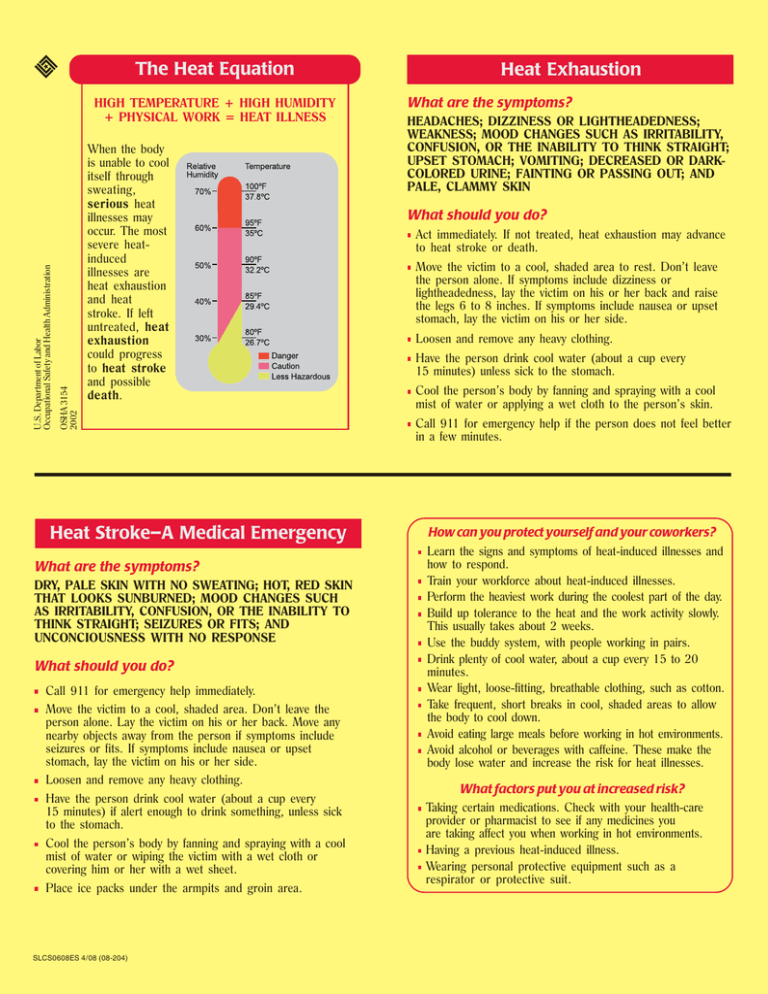
The Heat Equation OSHA 3154 2002 U.S. Department of Labor Occupational Safety and Health Administration HIGH TEMPERATURE + HIGH HUMIDITY + PHYSICAL WORK = HEAT ILLNESS When the body is unable to cool itself through sweating, serious heat illnesses may occur. The most severe heatinduced illnesses are heat exhaustion and heat stroke. If left untreated, heat exhaustion could progress to heat stroke and possible death. Heat Stroke–A Medical Emergency What are the symptoms? DRY, PALE SKIN WITH NO SWEATING; HOT, RED SKIN THAT LOOKS SUNBURNED; MOOD CHANGES SUCH AS IRRITABILITY, CONFUSION, OR THE INABILITY TO THINK STRAIGHT; SEIZURES OR FITS; AND UNCONCIOUSNESS WITH NO RESPONSE What should you do? Call 911 for emergency help immediately. Move the victim to a cool, shaded area. Don’t leave the person alone. Lay the victim on his or her back. Move any nearby objects away from the person if symptoms include seizures or fits. If symptoms include nausea or upset stomach, lay the victim on his or her side. Loosen and remove any heavy clothing. Have the person drink cool water (about a cup every 15 minutes) if alert enough to drink something, unless sick to the stomach. Cool the person’s body by fanning and spraying with a cool mist of water or wiping the victim with a wet cloth or covering him or her with a wet sheet. Place ice packs under the armpits and groin area. SLCS0608ES 4/08 (08-204) Heat Exhaustion What are the symptoms? HEADACHES; DIZZINESS OR LIGHTHEADEDNESS; WEAKNESS; MOOD CHANGES SUCH AS IRRITABILITY, CONFUSION, OR THE INABILITY TO THINK STRAIGHT; UPSET STOMACH; VOMITING; DECREASED OR DARKCOLORED URINE; FAINTING OR PASSING OUT; AND PALE, CLAMMY SKIN What should you do? Act immediately. If not treated, heat exhaustion may advance to heat stroke or death. Move the victim to a cool, shaded area to rest. Don’t leave the person alone. If symptoms include dizziness or lightheadedness, lay the victim on his or her back and raise the legs 6 to 8 inches. If symptoms include nausea or upset stomach, lay the victim on his or her side. Loosen and remove any heavy clothing. Have the person drink cool water (about a cup every 15 minutes) unless sick to the stomach. Cool the person’s body by fanning and spraying with a cool mist of water or applying a wet cloth to the person’s skin. Call 911 for emergency help if the person does not feel better in a few minutes. How can you protect yourself and your coworkers? Learn the signs and symptoms of heat-induced illnesses and how to respond. Train your workforce about heat-induced illnesses. Perform the heaviest work during the coolest part of the day. Build up tolerance to the heat and the work activity slowly. This usually takes about 2 weeks. Use the buddy system, with people working in pairs. Drink plenty of cool water, about a cup every 15 to 20 minutes. Wear light, loose-fitting, breathable clothing, such as cotton. Take frequent, short breaks in cool, shaded areas to allow the body to cool down. Avoid eating large meals before working in hot environments. Avoid alcohol or beverages with caffeine. These make the body lose water and increase the risk for heat illnesses. What factors put you at increased risk? Taking certain medications. Check with your health-care provider or pharmacist to see if any medicines you are taking affect you when working in hot environments. Having a previous heat-induced illness. Wearing personal protective equipment such as a respirator or protective suit. OSHA 3155 2002 (Revisado) Departamento de Trabajo de los EE.UU. Administración de Seguridad y Salud Ocupacionales La ecuación del calor TEMPERATURA ALTA + HUMEDAD ALTA + TRABAJO FÍSICO = ENFERMEDADES POR EL CALOR Cuando el cuerpo es incapaz de enfriarse mediante el sudor, pueden ocurrir serias enfermedades debidas al calor. Las más severas enfermedades debidas al calor son el agotamiento y la insolación. Si no se trata el agotamiento inmediatamente, puede ocurrir una insolación y e inclusive la muerte. Agotamiento ¿Cuáles son los síntomas? DOLORES DE CABEZA, MAREOS, DEBILIDAD, CAMBIOS DE HUMOR COMO LA IRRITACIÓN, LA CONFUSIÓN, O LA INHABILIDAD DE PENSAR CLARAMENTE, DOLORES DE ESTÓMAGO, VÓMITOS, ORINA DISMINUIDA O DE COLOR OSCURO, DESMAYOS, Y PIEL PÁLIDA Y PEGAJOSA. ¿Qué se debe hacer? ■ ■ ■ ■ ■ ■ Actuar inmediatamente. Si no se trata inmediatamente el agotamiento puede ocurrir una insolación e inclusive la muerte. Mueva la víctima a un lugar fresco y con sombra para que pueda descansar. No deje a la persona sola. Si los síntomas incluyen mareos o debilidad, acueste a la víctima de espalda y levántele las piernas 6 a 8 pulgadas. Si los síntomas incluyen náuseas o dolor de estómago, acueste a la víctima de lado. Suelte y remueva ropa pesada. Haga que la persona beba agua fría (aproximadamente una taza cada 15 minutos) a menos que la persona se sienta mal del estómago. Enfríe el cuerpo de la persona abanicándola, rociando agua o pasándole una toallita mojada por la piel. Si la persona no se siente mejor llame al 911 para pedir ayuda. La insolación – Una emergencia médica ¿ Cuáles son los síntomas? PIEL SECA, PÁLIDA Y SIN SUDOR; PIEL ROJA, CALIENTE Y QUE PARECE QUEMADA POR EL SOL; CAMBIOS DE HUMOR COMO LA IRRITACIÓN, LA CONFUSIÓN, O LA INHABILIDAD DE PENSAR CLARAMENTE; CONVULSIONES O ATAQUES; Y PERDER EL CONOCIMIENTO SIN NINGUNA REACCIÓN. ¿ Qué se debe hacer? ■ ■ ■ ■ ■ ■ Llame al 911 inmediatamente. Mueva la víctima a un lugar fresco y con sombra. No deje a la persona sola. Acueste a la víctima de espalda. Si los síntomas incluyen convulsiones, desplace todo objeto cercano a la persona. Si los síntomas incluyen náuseas o dolor de estómago, acueste a la víctima de lado. Suelte y remueva ropa pesada. Haga que la persona beba agua fría (aproximadamente una taza cada 15 minutos) a menos que la persona se sienta mal del estómago. Enfríe el cuerpo de la persona abanicándola, rociando agua o pasándole una toallita mojada por la piel. Coloque bolsas de hielo en las axilas y en la ingle. SLCS0608ES 4/08 (08-204) ¿ Cómo pueden protegerse usted y sus compañeros de trabajo? ■ ■ ■ ■ ■ ■ ■ ■ ■ ■ Sepa cuáles son las indicaciones y los síntomas de las enfermedades debidas al calor y como responder en caso necesitarse ayuda. Eduque a su equipo de trabajo sobre las enfermedades debidas al calor. Realice los trabajos pesados en las horas más frescas del día. Desarrolle lentamente la tolerancia al calor y a la actividad laboral. Esto usualmente requiere 2 semanas. Utilice un sistema de colegas con dos personas por tarea. Beba mucha agua fría, por lo menos una taza cada 15 a 20 minutos. Utilice ropa liviana, suelta y que permita sudar, como el algodón. Tome descansos cortos y frecuentes en lugares sombreados para permitir que el cuerpo se enfríe. Evite comer mucho antes de trabajar en el calor. Evite el alcohol o las bebidas con cafeína ya que deshidratan al cuerpo y aumentan el riesgo de enfermedades debidas al calor. ¿Qué son los factores de mayor riesgo? ■ ■ ■ Tomar ciertas medicinas. Consulte a su doctor o a su farmacéutico para saber si las medicinas que toma pueden tener efectos al trabajar en el calor. Haber tenido una enfermedad debida al calor anteriormente. Utilizar equipo protector como un equipo respiratorio o un saco protector.

